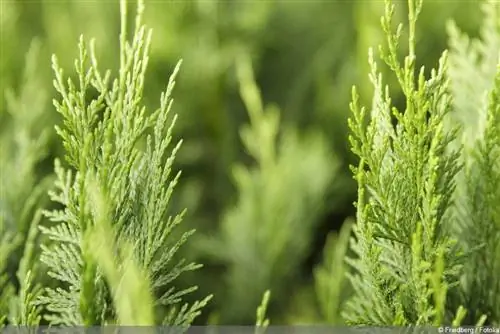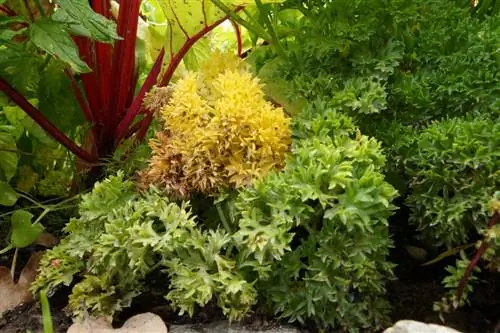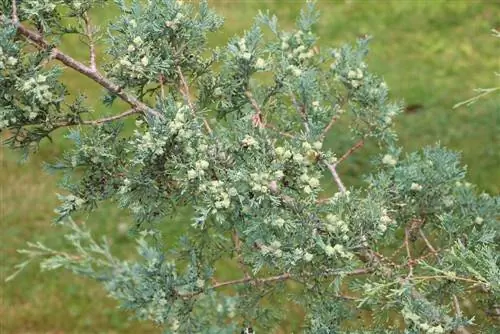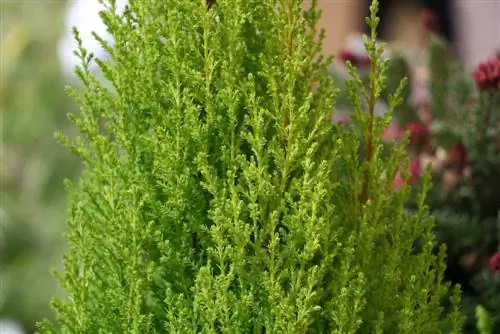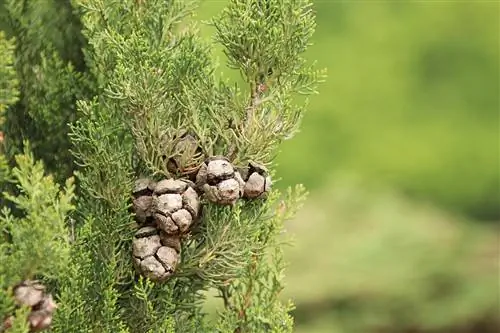- Author admin [email protected].
- Public 2023-12-17 03:39.
- Last modified 2025-01-24 12:45.
She is something of an impostor: the yellow cypress has absolutely nothing to do with a cypress. That's why she deserves her name. It is strikingly similar to the cypress tree. Because of its special properties, it has made a career as a hedge plant in our gardens. One reason for this is certainly their great appearance. It is also relatively undemanding.
Art
Chamaecyparis lawsoniana, the botanical name of the false cypress, scores particularly well with its yellow offshoots. They set special accents in the green of the plant and look almost elegant. Their elegant growth matches this. He is upright, actually straight as an arrow. They form either a columnar or a cone shape. Depending on the variety, they can grow up to 15 m tall and reach a width of up to three meters. When planted together, false cypresses can be used to form a perfect and largely opaque hedge that looks extremely natural. Another advantage is that this evergreen plant is hardy and can withstand severe frost. However, it also has a few disadvantages that you should be aware of. These disadvantages are:
- high sensitivity to moisture
- does not grow on clayey soils
- regular pruning is essential
- cutting back must not extend into the wood
More than a dozen varieties are now available in specialist retailers. They differ in their color expression and in the maximum height that a plant can reach. The following varieties are particularly popular:
- Yvonne, forms a golden-yellow hedge and grows up to ten meters high
- Stardust, grows cone-shaped, widely branched, produces bright yellow leaves and grows up to 15 m high
- Stewartii, very fast and densely growing, overhanging shoots, golden yellow leaves and shoot tips, grows up to eight meters high
- Kelleris Gold, very slender growth habit, golden yellow leaves, grows up to five meters tall
- Lane, grows slender and columnar, lemon-colored leaves in summer, golden yellow and bronze in winter, reaches a height of up to eight meters
Note:
Not all commercially available varieties are suitable as hedges, as they can sometimes grow too broadly. Perfect hedge plants are the varieties Yvonne, Kelleris Gold and Lane.
Floor
Whether a false cypress tree grows and thrives depends primarily on the soil. The wrong soil can significantly slow down the growth of the plant or even cause it to die. The most important aspect of the soil is that it is deep or well-drained. So it should be able to drain water well. If the soil contains a relatively large amount of clay, it is completely unsuitable for the yellow cypress. As already mentioned, it cannot cope with wetness or waterlogging at all. If necessary, drainage must be incorporated into the ground. However, if the clay content is too high, the effort required is usually far too great. In addition, the soil should be slightly alkaline and particularly rich in nutrients.
Tip:
Before buying false cypresses, it is strongly recommended to carefully check the soil conditions at the chosen location. A hole should be dug at least one meter deep.
Location
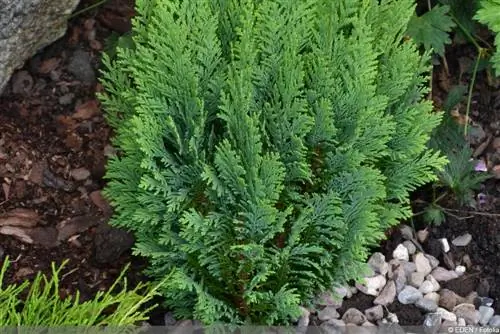
Chamaecyparis lawsoniana loves the sun and likes it bright. A sunny location is therefore ideal for it. However, the plant also copes relatively well with partial shade. It is also important that the location offers as much protection from wind as possible. Especially in winter, icy winds can otherwise cause frost damage to the otherwise hardy plant.
Note:
In a partially shaded location, the otherwise bright yellow leaves may have a rather dull color. The reason for this is simply the lack of sun.
Planting
Mock cypresses can generally be planted all year round. The only requirement for this is that the ground must not be frozen. It has proven to be ideal if the young plants are in the ground by the end of September at the latest. They then have enough time to root until the first frost comes. Before planting, the root ball is watered well in a bucket of water. The planting hole should be twice the size of the root ball. After planting, the soil is compacted well and watered immediately.
Care
The yellow cypress is a relatively undemanding plant that doesn't require a lot of work. The maintenance effort is therefore limited. However, you cannot avoid regular cutting if it is to be cultivated as a hedge plant. The following care tips will ensure that Chamaecyparis lawsoniana feels really comfortable:
Pouring
Cypress trees cannot tolerate moisture, but they do like it moist. If the soil dries out, it can quickly cause the plant's leaves to turn brown. In summer it is therefore imperative to regularly check the soil conditions in the root area. The soil should always be slightly moist and never dried out. Most of the time you can't avoid watering. You should water directly in the area of the roots. If the plant is watered from above, the remaining drops on the leaves can cause burns from sunlight. The drops act like a magnifying glass.
Fertilize
For proper growth, the yellow cypress also needs a proper supply of nutrients. Their needs are actually extremely large. During the growth phase, fertilization must therefore be carried out about once a month. The best way to do this is to use fertilizer from specialist retailers that is specifically tailored to hedge plants or conifers. It is also possible to use a long-term fertilizer, which means you can usually do without monthly fertilization. And of course, as a garden owner you can also mix humus or mulch into the soil.
Cutting
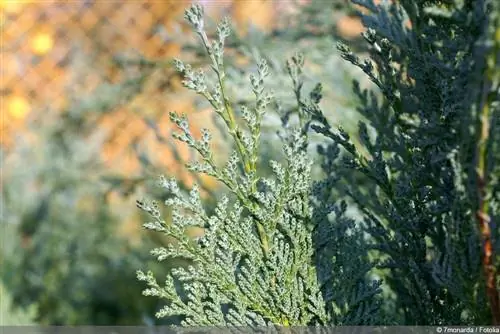
Mock cypresses need to be cut regularly - at least if they are to be used as hedge plants. Only this pruning ensures that the growth of the shoots is truly sustainable and particularly dense. As a rule, it is not possible to achieve an opaque hedge without pruning. In addition, pruning ensures that the plants do not grow too tall. Just a reminder: Some varieties can reach an impressive size of up to 15 m. At least one cut per year is therefore mandatory. The ideal time for this is early spring before new growth occurs. Depending on the intensity of the growth, a second cut can then be made in July. This is what you should keep in mind:
- use electric or mechanical hedge trimmers
- always cut rather tentatively and not too briskly
- always shorten the shoots
- never cut into or cut off wood
- orientate yourself towards natural growth (cone shape or columnar shape)
Basically, when it comes to pruning false cypresses, less is usually more. The plants generally tolerate pruning extremely well, but better growth can be achieved if they are not cut back too much during each pruning process. The following applies: It is better to prune carefully twice a year than to cut too hard once.
Tip:
Pruning to limit the height of the false cypress should definitely be done in several stages. In any case, you should get it to the desired height with just one cut.
It is also important in this context that the clippings should not be disposed of in the compost. Namely, it contains certain toxins that can significantly affect rotting. The cut branches are best chopped up with a shredder and then used, for example, to cover the root area of the plants.
Wintering
Overwintering the yellow cypress is not necessary and in most cases it is not possible. The plant is known to be hardy. Nevertheless, it of course makes sense to protect them a little during the cold season. This is especially true if the location has little protection from wind. It is generally recommended that the root area be provided with a thick layer of bark, mulch, leaves or chopped branches. The plant can get through the winter without this cozy blanket, but with it it is less stressed and therefore usually grows better in the coming spring.

